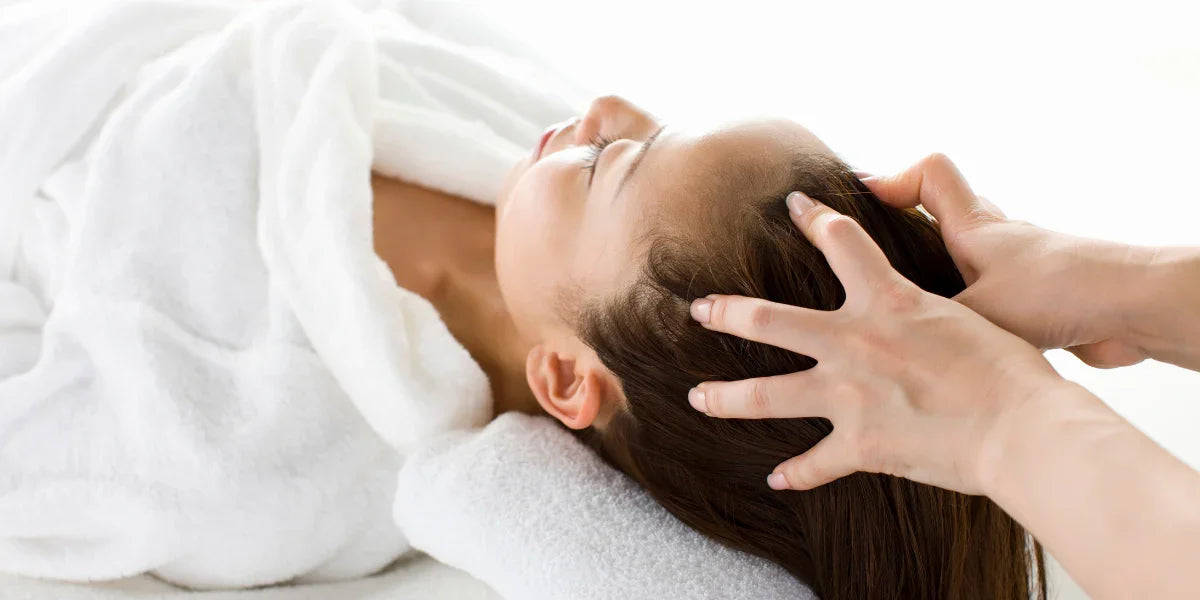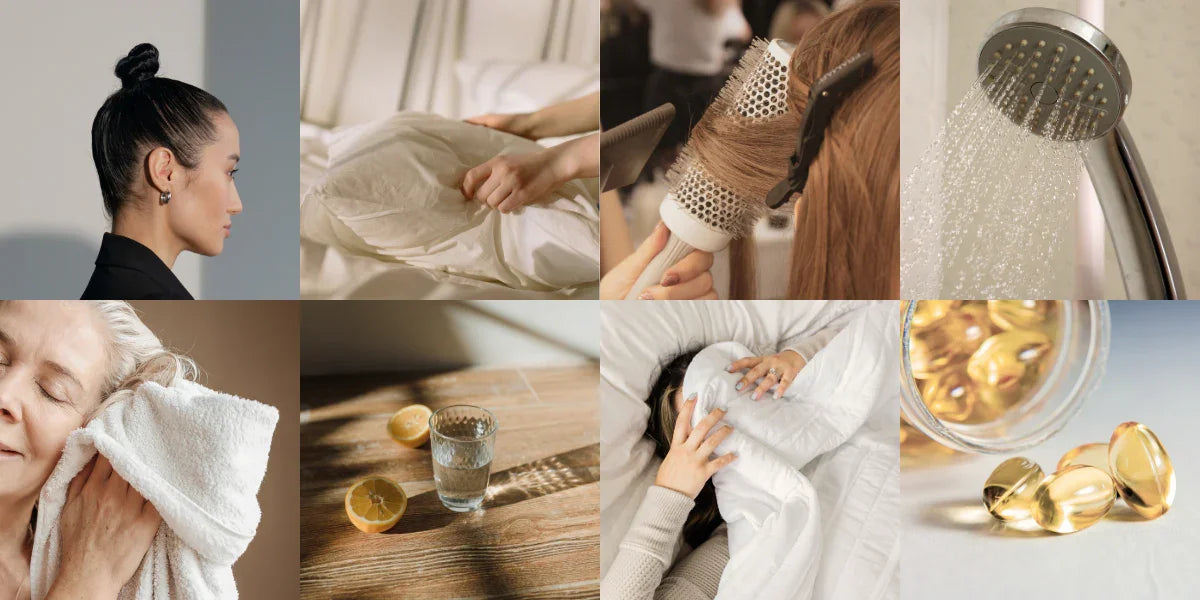
Scalp care: what do you need to know to grow long hair and stop hair loss?
Scalp care: what do you need to know to grow long hair and stop hair loss?
Dry ends, brittle hair, slow growth or hair loss? It may not be the mask or conditioner. And not even in genetics. More often than not, the problem is in the scalp.
We are used to focusing on what we see - on the length, and to a certain extent, this is correct. However, the length is already a “lifeless part” of the hair, which has no follicles and is not able to renew itself. If you want to have healthy hair from the roots, it is important to understand that care should start with the scalp. After all, the beautiful look of your strands is a regular set of actions you take for your scalp and along the entire length of your hair.
The scalp, like the skin of the face, needs 4 stages of care:
- regular cleansing.
- sufficient moisturizing.
- A silk towel or silk turban to absorb moisture.
- regularity.
Note: we will write about this in more detail in the middle of the article, but for now, let's figure out what the scalp is in the context of the whole body.
The scalp consists of layers of soft tissue covering the skull. It is an anatomical area bounded in front by the human face and on the sides and back by the neck. Aesthetically, it serves as an area where hair can grow, and physically, it is a barrier that protects the body from outside stimuli. It is a continuation of the skin on our face, which is just as vulnerable to aging, sun exposure, irritation, itching, and dryness.

Image "Layers of the Scalp" by Frank Gillard. License: CC BY-SA 3.0.
Do you want soft, thick and healthy hair? Start with the most important thing - the right Scalp Care!
Although the scalp has a lot in common with the skin on your body, it has its own unique characteristics. As experts explain, the scalp is home to about 100,000 hair follicles - and it has the highest number of sebaceous glands of any part of the body.

Structure of the hair follicle. Source: infobiz.com.ua.
These sebaceous glands produce sebum, a natural oil that moisturizes the skin and hair. The amount of sebum is different for everyone: people with dry scalp produce sebum more slowly, while those with oily scalp produce it more actively. And this balance affects not only comfort but also the appearance and quality of hair.
At the same time, it is precisely because of this activity of the sebaceous glands that the barrier function of the scalp is somewhat weaker than, for example, on the face or body. This means that it is more difficult for it to recover, retain moisture, and resist external stimuli. And given that the scalp is often exposed to the sun, heat, air, and styling products, it needs more care and attention.
And most importantly, scalp health directly affects hair health. After all, each follicle is a small factory deeply embedded in the skin. If the soil is weak, the plant will not grow strong. It's the same with hair.
According to experts, hair growth begins beneath the surface of the skin, long before it appears on the outside. This means that everything that affects strand formation starts in the dermal layer of the scalp. That's why taking care of your scalp is not just an extra step in your care routine, but a strategic investment in thick, strong, and healthy hair.
If the scalp is not properly cared for, hair growth slows down and new hair grows weak and thin.
Reminder! If home scalp care doesn't work, it's time to consult a trichologist. Your hair deserves a professional approach (without experiments).
This table will help you check what's wrong with your scalp
| How the scalp behaves without proper care | How healthy, well-cared-for scalp behaves |
| Hair grows slowly - follicles are clogged, blood circulation is poor | Hair grows more actively - follicles "breathe", are well nourished |
| Hair is brittle and dry - follicle is weak, the skin is dehydrated | Hair is strong and shiny - the roots are nourished |
| A lot of thin, frizzy hair appears and falls out quickly | New hair is thicker and longer because it holds together better |
| Persistent hair loss - due to inflammation or fat blocking follicles | Normal hair renewal, without loss of volume |
| Itching, irritation, dandruff - microbiome balance is disturbed | Comfort, freshness - no desire to "scratch your head” |
| Skin quickly becomes oily or flaky - sebaceous glands work chaotically | Skin in balance - no need to wash your hair often |
| Follicles "sleep", pores are clogged - this inhibits the growth of new hair | Follicles are active, growth is stimulated |
| Disturbed microbiome - skin is not protected, problems arise more easily | Healthy microbiome supports strong roots and protects against inflammation |
Why is the priority of scalp care non-negotiable? It's simple - hair growth starts with the scalp.
If scalp care isn't already part of your daily beauty ritual, it's time to start. Here are 6 simple and straightforward steps to improve your condition:
Step 1. Proper cleansing.
Since the scalp is just an extension of the face, it often corresponds to the same skin type as the T-zone. If it is oily, then the scalp is usually oily too, which means that the shampoo should be for oily skin.
1 time per week - deep cleansing to remove sebum, dust, and styling products.
Step 2. Peeling or scrubbing.
It is like exfoliation for the face - removes dead cells, stimulates blood circulation, “unlocks” the follicles.
1-2 times a week.
Step 3. Light massage.
Gentle massage with your hands or a special massager activates blood flow to the roots, stimulates the growth of new hair and relaxes.

Step 4. Protect the microbiome.
Do not buy aggressive shampoos and avoid irregular washing. Wash only as much as your scalp needs.
The microbiome is a living protective layer that should be kept in balance.
Step 5. Replace a regular towel with a silk turban.
A silk turban reduces the risk of hair breakage and keeps the skin microbiome in good condition. After all, natural silk is hypoallergenic and antibacterial.
We previously wrote a lengthy article about the benefits of the same turban, click and read about its real impact on hair.
Step 6. Regularity.
As with facial care, the effect of scalp care is cumulative. Do it systematically and you'll notice the difference in a few weeks.
Small lifestyle changes will improve the condition of your scalp.
5 small habits that you should get used to now.
1. Drink more water.
Moisturizing from the inside out is a must. Dry skin = weak hair.

2. Eat less sugar.
Sugar is inflammation. Inflammation means itching, dandruff, and slow growth.
3. Limit alcohol.
Alcohol dehydrates and slows down the follicles.
4. Add “hair food” to your diet.
Avocados, berries, eggs, spinach, salmon - all that nourishes the hair from the inside.

5. Sleep, breathe, and stress less.
Chronic stress leads to chronic hair loss. The scalp is the first to feel it.
Small changes make a big difference. Scalp Care Starts with Conscious Decisions.
What you should stop believing - 3 myths about scalp care.
Myth: Washing your hair less often is better for your scalp.
Truth: It depends on your hair type, lifestyle, and the products you use. Infrequent washing can cause buildup and irritation, especially for oily scalps.
Myth: Having an oily scalp means you don't need to moisturize.
Truth: Oily and moisturizing are different. An oily scalp can still be dehydrated, leading to excessive sebum production. Use lightweight moisturizers - be sure to consult a trichologist.
Myth: Dandruff is just dry skin that results from poor hygiene.
Truth: Dandruff is caused by excessive sebum production and yeast overgrowth, not by dryness or insufficient washing. Use anti-dandruff shampoos with zinc or salicylic acid to treat it.
Conclusions
When you ignore your scalp, problems build up.
The buildup from styling products, sweat, and oils can lead to dandruff, itchiness, and even inflammation. And while dry flakes and an oily scalp may seem like minor irritants, they are signs that your scalp is not functioning properly. Long-term neglect can contribute to thinning, brittle, and dull hair.
What to do first?
- Find a trichologist and make an appointment.
- Write down everything that bothers you. Be sincere and honest.
- Follow all the recommendations of the trichologist at home.
- Replace a regular towel with a silk turban.
- Make scalp care a habit.
Taking care of your scalp is not a trend, but a long-term investment in the strength, thickness and beauty of your hair.




